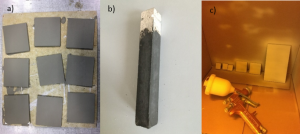![]() 24/01/2022
24/01/2022
Development of Polymer Derived Ceramics coatings for high-temperature corrosion protection
In ACHIEF project, CEA will be leading the development of the Polymer Derived Ceramic (PDC) coatings for high-temperature corrosion protection. The goal of this activity is to create easily applicable and cheap anti-corrosive coating based PDC, as well as fillers for industrial user case. To achieve this, CEA will work closely with two other partners, Constellium and TUPRAS, for 2,5 years.
Corrosion is one of the most important challenges facing aluminium foundry and petrochemical refineries. In the recent decades, it has received wide attention. In ACHIEF’s industrial user cases, acidic environment or melted aluminium alloy cause corrosion.
The acidic environment vapors or melted aluminium alloy cause both general and localized corrosion. This damaging process is very aggressive to most common materials of construction (steel pipelines) or of foundry components (graphite rotors, ovens, refractory bricks…).
For all these different cases, CEA and the partners will aim to reduce the defects and replace the frequency of the equipment. Furthermore, they will also aim to increase the durability and decrease the corrosion rate. As a result, the partners expect to save costs related to the production and energy consumption.
Precursors as Polymer-Derived Ceramics (PDCs) are able to transform into a silicon-based ceramic upon pyrolysis. In addition, PDC could be mix with solvent and with different charges and fillers. The nature of the charge could have several properties: inert, or active charge for limiting cracks and wettability.
Currently, CEA is evaluating and testing several PDC composites at a laboratory scale. Firstly, CEA is screening different materials, precursors, charges and fillers. Preliminary tests on different substrates such as refractory, graphite and steel are also to be carried out. Moreover, CEA is also working on the first formulation of the coatings (deposition by doctor blade, paintbrush and spray). Finally, CEA will complete the first evaluation and characterization of the SEM pictures, microstructure, adhesion.

Figure 1 : a) specific coatings on steel substrate for HCl environment, b) coating based on Boron Nitride (BN) powder on a refractory bar c) preliminary spray tests before thermal treatment.
CEA is also currently developing a specific test bench for corrosion due to acidic dew point.




